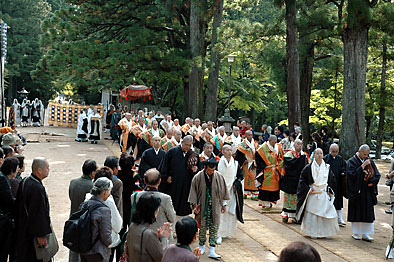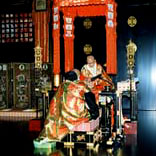
Taizokai: May 3-5, Kongokai: October 1-3, Garan Kondo
“Taizokai Kechien Kanjo on May 3-5, and “Kondokai Kechien Kanjo on October 1-3 will he held at Daigaran and Kondo.
In this ceremony, by throwing a flower into a mandala representing the world of the Buddha, a connection (Kechien) is made with the Buddha (Mikkyou noble teaching), and by pouring water of the Dainichi Nyorai over the head by the Ajari (known as Kanjo), everybody’s souls will be purified and will be guided and opened to the soul and wisdom of the Buddha. At Koyasan, this is a greatly important ritual, along with the previous “Daimandaraku.” We are touched by this sacred opportunity, and pray to receive a rich soul.

On the opening days in May and October, before the Nyudan, the ceremony of “Teigi Kechien Kanjo Sanmayakai” is held. Please be blessed with the “dharma” for which Mikkyou is grateful. Regardless of being a priest and layman, anyone can make a connection with the various Buddhas of the Kongo and Taizo. Recipients are marked with a symbol and Shingon, and then both eyes are covered. Before the mark, a flower given, and the recipient is shown to the mandala.. Then, by throwing the flower into the mandala, the link is made with the “Butsuren” of the Buddhas of the mandala. This is called “Toukeku Butsu.” Next, the wisdom water of the Nyorai is poured by the Ajari. By doing this, we receive a lighted guideposts to navigate the darkness of worldly desires.
Our possessions are especially unnecessary, but those who have rosaries or stoles, please bring them.
This ceremony is very ancient, with there being records of Daishi performingKongokai in November Kounin 3 (812), Takaoyama in Kyoto, and continuing until December with the Taizo Kanjo.
Now, we will discuss the difference between the Kon and Tai Kechien Kanjo. Fundamentally, Kongokai is reverence for Kongokai, and Taizokai is reverence and kechien for the Taizo, but if looked at from a slightly different perspective, Kongokai shows roots in the Kongo Chogyo system , and by expressing the wisdom of the Dainichi Nyorai, and aims at exemplifying everyone’s aspiration for Buddhahood and wisdom of the Buddha. Taizo, having roots in the ideas of the Dainichikyo system, the inherent aspiration for Buddhahood and reason held by everyone being is nurtured by numerous formations, lets the person experience the world. If explained like this, you probably would think, “How difficult that is,” but in returning to the first discussion, let’s make a connection with the Buddhas of Kon and Tai, spring up with “gratitude” in the soul for the Buddha, use that as a clue to the soul, and live our lives to get along with others and living things.
We are ask for an entrance donation of ¥ 5,000 per person.